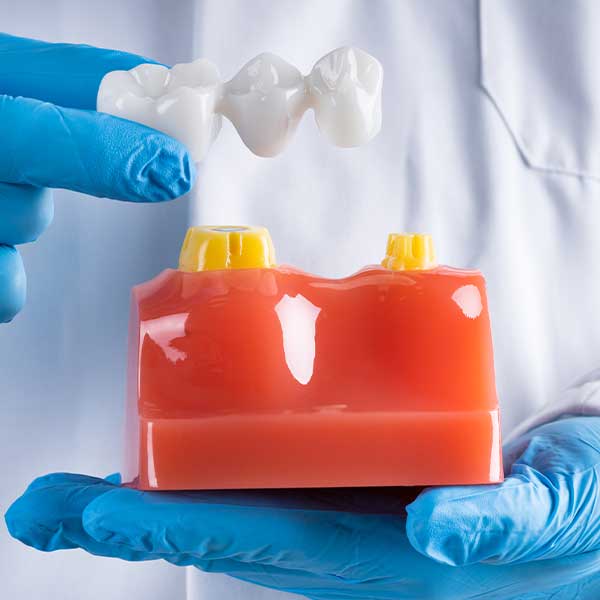Crowns & Bridges
What is a crown?
A crown is a restoration that fits over the whole remaining part of a tooth, making it strong and giving it the shape of a natural tooth. A crown is sometimes known as a ‘cap’. A crown is recommended when there is extensive tooth structure loss and a filling will not be strong enough for normal function.
What is a bridge?
Bridges are one treatment method for replacing missing teeth. They are fixed dental prostheses cemented permanently to adjacent teeth or dental implants. They can be used to replace one or several missing teeth. A false tooth (pontic) on the bridge is fused to two porcelain crowns to fill in the area left by a missing tooth. The two crowns holding it in place are cemented to teeth on each side of the false tooth.How long does the treatment take?
You will need to have at least two visits. At the first visit, your dental team will prepare the tooth, take the impressions, make a note of the shade of your tooth, and fit the temporary crown (if required). At the second visit, your dentist will fit the permanent crown. There will usually be about 2-3 weeks between appointments.What is a post-core crown?
In root-filled teeth, it may be necessary to insert a post into the tooth root before placing a crown. A post gives support and helps the preliminary restoration of the crown to stay in place. A post and core can be direct or indirect and fits into the root canal of the tooth. The fabricated crown will then be cemented onto it.What will happen between visits?
A temporary crown will be placed while you are waiting for the crown to be made. This crown may be more noticeable but is only temporary.How is the crown fitted?
When you and your dentist are happy with the fit and appearance of the new crown, it will be fixed in place with special dental cement. The cement forms a seal to hold the crown in place.How do I care for my crown?
It is important to keep the crown just as clean as you would your natural teeth. The crown itself cannot decay, but decay can start where the edge of the crown joins the tooth. So daily brushing and flossing is recommended.How long will the crown last?
How long your crown lasts depend on how well you look after it. Properly cared for crowns should last for many years.When would I need a crown?
Cover discoloured or worn teeth
If you feel that your teeth are becoming more transparent or becoming darker in colour, they may be wearing down. Your dentist will discuss the reasons behind this as it is important that they are addressed first. If your dentist recommends a crown restoration, then this crown will be fabricated to resemble the natural shape and strength of your existing teeth through the use of ceramic material.
Replacement of a large filling
If your teeth are heavily filled, they may be at risk of fractures or de-bonding of fillings. Frequent replacement of fillings can lead to loss of precious tooth structure. Repeated dental treatment on the same tooth may lead to deepening of the filling and subsequent nerve inflammation. To avoid these complications, your dentist may recommend that a crown is constructed before the filling becomes too large and remaining tooth structure is too short to support a crown.
To stop a tooth from further cracking or fracturing
If your tooth is showing fine lines and cracks or you occasionally feel sensitivity when biting into sticky or hard foods, your tooth may have a deep crack or may be at risk of complete fracture. This is common for heavily filled teeth, especially where an amalgam filling is in place. Your dentist may recommend a crown to restore the tooth and protect its cusps from splitting apart and may suggest replacing any amalgam with a ceramic restoration.
To anchor a bridge replacing a missing tooth
If a tooth is missing or lost, your dentist will discuss the options for tooth replacement. This may involve the placement of an implant or tooth-supported bridge. If two or more teeth directly adjacent to the lost or missing tooth are at risk of fracture or are discoloured and need crowns, a bridge may be a good option to replace the missing tooth. When the bridge is fabricated, a false tooth (pontic) is fused to the two or more crowns on either side and once the crowns are fitted onto the adjoining teeth, the porcelain pontic appears to be emerging out of the gum. A bridge may be a suitable course of treatment for you if you are unable to have an implant.
After root canal treatment
Root canal-filled teeth are prone to fractures. Dentists highly recommend crowning most root canal-filled teeth to protect them from fractures and further bacterial infections.
* We are affordable dentists with quality work. All the crowns used in Robina Family Dental Surgery are made in Australia.
